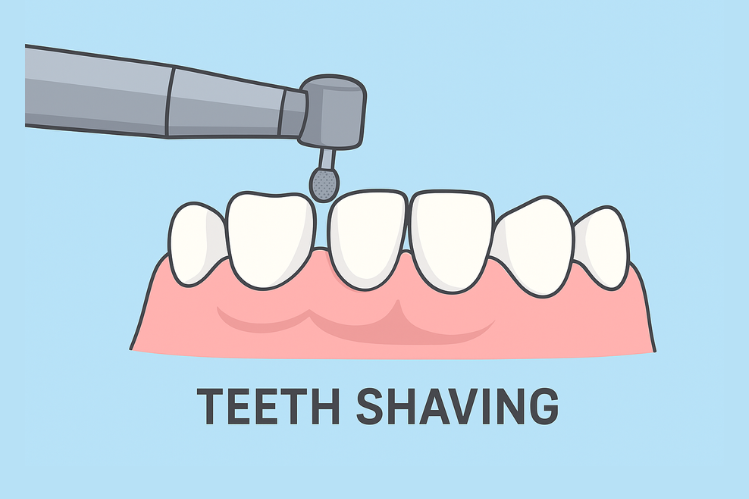
Table des matières
- Que signifie le rasage des dents ?
- Les facettes dentaires nécessitent-elles un limage des dents à chaque fois ?
- Quelle quantité de dent est taillée pour la pose de facettes ?
- Facettes dentaires sans préparation : une option moins invasive
- Aligneurs transparents : l’option la plus simple et la plus sûre
- Risques liés au limage des dents pour la pose de facettes dentaires
- Le limage des dents est-il nécessaire pour la pose de facettes dentaires ?
- FAQ
Les facettes dentaires gagnent en popularité au fil du temps. La nouvelle vague du sourire hollywoodien et l'ère des facettes dentaires Sur les réseaux sociaux, les gens recherchent des solutions rapides pour embellir leur sourire. Ils apprécient la commodité et la rapidité. Outre les résultats prometteurs des facettes dentaires, beaucoup redoutent également le « meulage des dents » nécessaire à la préparation des dents pour la pose de facettes. Est-ce toujours nécessaire ?
Dans ce blog, nous explorerons les situations où la préparation des dents est nécessaire, la quantité de dent généralement taillée, et quelles sont les options disponibles pour les facettes nécessitant une préparation minimale et les facettes sans préparation, hormis les facettes en porcelaine ?
Que signifie le rasage des dents ?
Le meulage dentaire, aussi appelé préparation de la dent, consiste à retirer une très fine couche d'émail par le dentiste. une couche située à l'avant de vos dents, généralement minuscule, souvent inférieure à un demi-millimètre, ce qui est minime. Une étape minutieuse et précise permet de préparer les facettes. Sans ce meulage, les facettes pourraient paraître épaisses, irrégulières ou… Mordre n'est tout simplement pas naturel, ce qui n'est évidemment pas idéal.
Pour les facettes traditionnelles, le meulage joue un rôle important. Il permet :
- Une fixation sûre : les facettes adhèrent fermement à la dent, réduisant ainsi le risque de glissement ou de décollement. temps.
- Un aspect naturel : grâce à la finition de l’émail, les facettes se fondent harmonieusement dans votre environnement. dents. Cela donne à votre sourire un aspect équilibré et naturel.
- Durabilité à long terme : Une préparation dentaire adéquate favorise une meilleure adhésion des facettes, ce qui les rend plus résistantes. résistant aux ébréchures, aux fissures et à l'usure prématurée.
Considérez le limage des dents comme une façon de remodeler la dent pour que les facettes dentaires aient l'air et la sensation d'une partie naturelle de votre sourire. Souriez. Bien que cela puisse paraître intimidant, la procédure est indolore et ne nécessite généralement qu'une anesthésie locale.
Les facettes dentaires nécessitent-elles un limage des dents à chaque fois ?
Pas toujours. La nécessité pour votre dentiste de limer vos dents dépend du type de facettes que vous choisissez et de votre… Cas dentaire particulier.
- Facettes traditionnelles : Nécessitent presque toujours un enlèvement partiel d'émail.
- Facettes dentaires à préparation minimale : Elles nécessitent un léger meulage de la dent, juste ce qu’il faut pour que la facette s’adapte parfaitement. sans accroc.
- Facettes sans préparation : Ces coquilles ultra-minces peuvent parfois être posées sans aucun retrait d'émail. tous.
La réponse est donc : cela dépend de votre plan de traitement et de vos objectifs esthétiques.
Quelle quantité de dent est taillée pour la pose de facettes ?
La quantité d'émail enlevée est généralement minime. Dans la plupart des cas, les dentistes enlèvent environ 0,3 à 0,7 mm. mm , soit environ l'épaisseur d'un ongle. Bien que cela puisse paraître peu, c'est suffisant pour que les facettes dentaires s'adaptent parfaitement. Un teint frais et un aspect naturel.
Facettes dentaires sans préparation : une option moins invasive

Si l'idée de vous faire limer les dents vous angoisse, l' option des facettes sans préparation pourrait vous sembler idéale. Une alternative parfaite. Ces facettes sont conçues pour être extrêmement fines, souvent aussi fines qu'une lentille de contact, ce qui leur permet de… Elles sont généralement placées directement sur vos dents naturelles sans enlever beaucoup, voire pas du tout, d'émail.
Les avantages des facettes sans préparation, qui s'apparentent à des options à intervention minimale, sont les suivants :
- Peu ou pas d'élimination d'émail : vos dents naturelles, en grande partie intactes, restent à peu près tels quels.
- Un processus de traitement plus rapide : comme la préparation est minimale, les choses peuvent aller plus vite. plus rapidement que les placages traditionnels, qui prennent généralement plus de temps.
- Risque de sensibilité réduit : l’émail n’est pas vraiment altéré, donc la sensibilité post-traitement, Le type de problème qui dérange parfois les patients est moins probable.
- Réversibles dans certains cas : Parfois, si vous souhaitez retrouver votre sourire d’origine, les facettes dentaires sans préparation sont une solution. peut effectivement être retiré, selon la situation, bien sûr.
Cependant, les facettes sans préparation ne constituent pas une solution universelle. Si vos dents sont chevauchées, tordues ou très décolorées, une Le dentiste devra peut-être encore effectuer quelques préparations pour que les facettes s'adaptent bien et aient un aspect naturel. Elles sont généralement plus efficaces pour patients présentant des problèmes esthétiques mineurs, tels que de petits espaces, une légère décoloration ou des bords usés.
En résumé, les facettes dentaires sans préparation offrent une approche plus conservatrice qui séduit les personnes souhaitant des améliorations esthétiques. sans modifier définitivement leurs dents. Seul un professionnel dentaire peut confirmer si cette option est la plus appropriée. pour atteindre vos objectifs de sourire.
Aligneurs transparents : l’option la plus simple et la plus sûre
Si vous souhaitez corriger votre sourire le plus simplement possible, les aligneurs transparents sont la solution la plus facile et la moins risquée. Cette option ne nécessite ni limage ni forage des dents. Aucun changement permanent pour vos dents. Juste une dentition lisse. et un processus sûr.
Avantages des aligneurs transparents :
- Elles sont quasiment invisibles, donc personne ne peut savoir que vous les portez.
- Vous pouvez les retirer pour manger ou vous brosser les dents.
- Vous pouvez manger ce que vous voulez sans stress
- Elles sont douces et confortables comparées aux appareils dentaires.
- Ils préservent l'intégrité de vos dents naturelles.
- Ils donnent des résultats étape par étape, sans interventions dentaires angoissantes.
Les aligneurs transparents sont sûrs, simples et efficaces. C'est pourquoi tant de personnes les choisissent en premier lieu lorsqu'elles souhaitent améliorer leur sourire. leur sourire.
Risques liés au limage des dents pour la pose de facettes dentaires
Bien que le rasage de l'émail des dents soit sans danger lorsqu'il est effectué correctement, il est important de comprendre les risques potentiels :
- Sensibilité dentaire : Certains patients peuvent ressentir une sensibilité temporaire au chaud ou au froid.
- Perte définitive d'émail : Une fois l'émail limé, il ne repousse pas.
- Traitement irréversible : Les dents préparées nécessiteront toujours une forme de restauration, telle que Des facettes ou des couronnes, à l'avenir.
C’est pourquoi il est crucial de discuter de vos options avec un dentiste qualifié avant de vous engager dans un traitement. Voici plus d’informations. à propos des aligneurs transparents par rapport aux facettes dentaires si vous souhaitez approfondir le sujet.
Le limage des dents est-il nécessaire pour la pose de facettes dentaires ?
Le limage des dents fait souvent partie de la pose de facettes dentaires. La quantité de dent à lisser dépend de la forme de votre dent. Les dents. Mais grâce aux nouvelles méthodes, les personnes présentant des imperfections mineures peuvent opter pour des solutions moins invasives, comme les facettes sans préparation.
Si vous envisagez la pose de facettes dentaires, il est conseillé de consulter un professionnel afin de discuter de toutes les options possibles. Soyez attentif. de choisir un bon dentiste car les facettes dentaires peuvent parfois mal tourner lorsqu'elles sont posées par des professionnels non certifiés.
- Et si vous souhaitez des solutions simples à domicile pour embellir votre sourire, visitez le site web d'ALIGNERCO , où vous trouverez tout ce qu'il vous faut. Des aligneurs transparents aux appareils de contention, en passant par les kits de blanchiment dentaire.
FAQ
1. Peut-on poser des facettes dentaires sans limer les dents ?
Oui, certaines facettes dentaires ne nécessitent que peu ou pas de préparation. On les appelle facettes à préparation minimale ou sans préparation. Les facettes dentaires. Elles sont idéales pour les modifications mineures.
2. Faut-il toujours limer les dents pour la pose de facettes ?
Pas toujours. Les facettes traditionnelles nécessitent généralement un léger meulage pour un rendu naturel. Mais les facettes sans préparation… Plusieurs options sont disponibles en fonction de votre dentition et de vos objectifs.
Citations :
Académie américaine de dentisterie esthétique. Facettes en porcelaine https://yoursmilebecomesyou.com/procedures/cosmetic-dentistry/porcelain-veneers-usa
Farias-Neto, Arcelino, et al. « Réhabilitation esthétique du sourire avec des facettes en porcelaine sans préparation et des prothèses partielles » « Facettes dentaires ». Case Reports in Dentistry, vol. 2015, 2015, p. 1–6, www.ncbi.nlm.nih.gov/pmc/articles/PMC4628695/, https://doi.org/10.1155/2015/452765. Consulté le 1er mai 2019.




